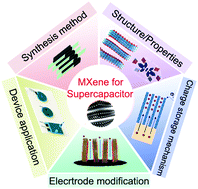Emerging 2D MXenes for supercapacitors: status, challenges and prospects
Abstract
MXenes refer to a family of 2D transition metal carbides/nitrides that are rich in chemistry. The first member of the family, Ti3C2Tx, was reported in 2011. Since then MXenes have opened up an exciting new field in 2D inorganic functional materials by virtue of their intrinsic electronic conductivity, superior hydrophilicity, rich surface chemistry and layered structure, as evidenced by the fact that the number of papers on MXenes has increased exponentially. The unique properties and ease of processing have positioned them as promising materials for a variety of applications including energy storage, especially for supercapacitors. In this review, we aim to summarize the current advances in MXene research on supercapacitors. We begin by reviewing various fabrication routes and their influence on the structure and surface chemistry of MXenes. The structure, properties, stability, and species of layered MXenes are then introduced. The focus then turns to the capacitive energy-storage mechanisms and the factors determining the electrochemical behavior and performance in supercapacitors. Besides, various types of MXene-based supercapacitors are summarized to highlight the significance of MXenes in constructing energy storage devices. Finally, challenges and prospects in this booming field are proposed to promote further development of MXenes in supercapacitors.



 Please wait while we load your content...
Please wait while we load your content...